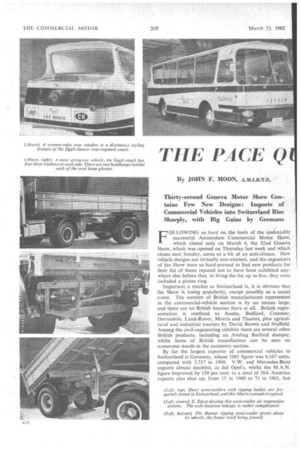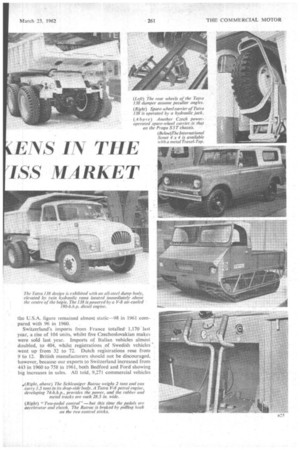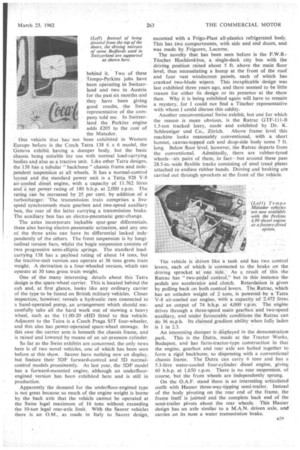THE PACE Q ENS IN THE LSS MARKET
Page 58

Page 59

Page 60

Page 63

If you've noticed an error in this article please click here to report it so we can fix it.
By JOHN F. MOON, A.M.I.R.T.E.
Thirty-second Geneva Motor Show Contains Few New Designs: Imports of Conmiercial Vehicles into Switzerland Rise Sharply, with Big Gains by Germans
FOLLOWING so hard on the heels of the undeniably successful Amsterdam Commercial Motor Show, which closed only on March 4, the 32nd Geneva Show, which was opened on Thursday last week and which closes next Sunday, came as a bit of an anticlimax. New vehicle designs are virtually non-existent, and the organizers of the Show were so hard-pressed to find new products for ' their list of items reputed not to have been exhibited anywhere else before that, to bring the list up to five, they even included a piston ring.
Important a market as Switzerland is, it is obvious that the Show is losing popularity, except possibly as a social event. The number of British manufacturers represented in the commercial-vehicle section is by no means large, and there are no British heavies there at all. British representation is confined to Austin, Bedford, Comrner, Dormobile, Land-Rover, Morris and Thames, plus agricultural and industrial tractors by David Brown and Nuffield. Among the civil-engineering exhibits there are several other British products, including an Aveling Barford dumper, whilst items of British manufacture can be seen on numerous stands in the accessory section.
By far the largest exporter of commercial vehicles to Switzerland is Germany, whose 1961 figure was 6,167 units, compared with 3,717 in 1960. V.W. and Mercedes-Benz exports almost doubled, as did Opel's, whilst the M.A.N. figure improved by 150 per cent. to a total of 264. Austrian exports also shot up, from 15 in 1960 to 71 in 1961, but the U.S.A. figure remained almost static-98 in 1961 com pared with 96 in 1960.
Switzerland's imports from France totalled. 1,170 -last year, a rise of 104 units, whilst five Czechoslovakian makes were sold last .year. Imports of Italian vehicles almost doubled, to 404, whilst registrations of Swedish vehicles ". went up from 32 to 72. Dutch registrations rose from 9 to 12. British manufacturers should not be discouraged, however, because our exports to Switzerland increased from 443 in 1960 to 758 in 1961, both Bedford and Ford showing big increases in sales. All told, 9,271 commercial vehicles
Amid this flood of foreign competition, Swiss vehicle production dropped slightly from 546 to 514. Saurer, of course, remained the largest manufacturer, the 1961 output being 297, whilst 118 vehicles were produced by Saurer's sister company, Berna. Apparently there is still a twoyear waiting list for Saurer vehicles, which obviously explains why the imports of German and Italian heavy vehicles have risen.
As from this year, the commercial-vehicle section of the Geneva Show becomes biennial. Only cars will be exhibited in Geneva next year. It is unfortunate that " even " years should have been selected for the Geneva Commercial Show, because the Dutch show also takes place on even years, as do the London and Paris exhibitions. " Odd-year " shows are the Brussels. Frankfurt and Glasgow gatherings, with the Turin Show at present in the balance, and still officially an annual event.
To my mind this timing is bad, as on even years it will mean two shows at the end of . winter within three weeks of each other—Amsterdam and Geneva—then a gap until the end of September when the London and Paris Shows almost fall. over each other, followed closely (presumably) by the Turin exhibition. In odd years, on the other hand,. the pattern will be entirely different—the Brussels Salon right at the beginning of the year, then a gap until the Frankfurt Show in September, after which comes the Turin and Glasgow Shows in November.
Nevertheless, so far as this year's Geneva Show is concerned it has still attracted entries from 17 countries all told. The British contingent is not the only small one. American vehicles, few and far between too, are limited to Chevrolet, International and Wayne. Austrian products on view include Steyr, Perl-Auhof and 0.A.F.; Czechoslovakia is represented by Praga, Skoda and Tatra, and France by Berliet, Citroen, Hotchkiss, Peugeot, Renault, Saviem, Simca and Unic.
R26
The list of German exhibitors is the most impressive of the lot, Germany regarding Switzerland as one of its favourite markets. Exhibitors include Ackerman, Blumhardt, Bussing, Eylert, Faun, Ford, Hanomag, Henschel, Kassbohrer, Krupp, Magirus-Deutz, M.A.N., MercedesBenz, Neoplan, Opel, Scheuerle, Tempo, Unimog anqit.W. Italian exhibits are limited to Autobianchi, Fiat and Lancia, whilst the Swedes are represented by Scania-Vabis. and Volvo.
From nearly all these makers there is nothing new whatsoever, though one exception is a Tempo Matador 30-cwt. model equipped with a Perkins 4.99 diesel engine. This is not a conversion, the unit now being offered as a factoryfitted option to the standard Austin A55 52-b.h.p. petrol engine. This is the first time this Perkins installation has been exhibited, and 12 months' development work lies behind it. Two of these Tempo-Perkins jobs have been operating in Switzerland and two in Austria for the past six months and they have been giving good results, the Swiss representative of the company told me. In Switzerland the Perkins engine adds £205 to the cost of the Matador.
One vehicle that has not been exhibited in Western Europe before is the Czech Tatra 138 6 x 6 model, the Geneva exhibit having a dumper body, but the basic chassis being suitable for use with normal load-carrying bodies and also as a tractive unit. Like other Tatra designs, the 138 has a tubular " backbone " chassis frame and independent suspension at all wheels. It has a normal-control layout and the standard power unit is a Tata, 928 V-8 air-cooled diesel engine, with a capacity of 11.762 litres and a net power rating of 180 b.h.p. at 2,000 r.p.m. The rating can be increased by 25 per cent. by addition of a' turbocharger. The transmission train comprises a fivespeed synchromesh main gearbox and two-speed auxiliary box, the rear of the latter carrying a transmission brake. The auxiliary box has an electro-pneumatic gear-change.
The axles incorporate lockable spur-gear differentials, these also having electro-pneumatic actuation, and any one of the three axles can have its differential locked independently of the others. The front suspension is by longitudinal torsion bars, whilst the bogie suspension consists of two progressive semi-elliptic springs. The standard loadcarrying 138 has a payload rating of about 14 tons, but the tractive-unit version can operate at 36 tons gross train weight. A derivation is a four-wheeled version, which can operate at 30 tons gross train weight.
One of the many interesting details about this Tatra design is the spare-wheel carrier. This is located behind the cab and, at first glance, looks like any ordinary carrier of the type to be found on British military vehicles. Closer inspection, however, reveals a hydraulic ram connected to a hand-operated pump, an arrangement which should successfully take all the hard work out of stowing a heavy wheel, such as the 11.00-20 eHD fitted to this vehicle. Adjacent to the Tatra is a Czech Praga S5T four-wheeler, and this also has power-operated spare-wheel stowage. In this case the carrier arm. is beneath the chassis frame, and is raised and lowered by means of an air-pressure cylinder.
So far as the Swiss exhibits are concerned, the only news here is of two novel vehicles, one of which has been seen before at this show. Sauter have nothing new on display, but feature their 5DF forward-control and 5D normalcontrol models prominently. As last year, the 5DF model has a forward-mounted engine, although an underfloor engined version has been exhibited here and is still in production.
Apparently the demand for the underfloor-engined type is not great because so much of the engine weight is borne by the back axle that the vehicle cannot be operated at the Swiss legal maximum of 16 tons without exceeding the 10-ton legal rear-axle limit. With the Saurer vehicles there is an 0.M., as made in Italy to Saurer design, mounted with a Frigo-Plast all-plastics refrigerated body. This has two compartments, with side and end doors, and was made by Frigorex, Lucerne.
The novelty that has been seen before is the F.W.B.Tiischer Hochlenkbus, a single-deck city bus with the driving position raised about 5 ft. above the main floor level, thus necessitating a hump at the front of the roof and four vast windscreen panels, each of which has cranked two-blade wipers. This inexplicable design' was last exhibited three years ago, and there seemed to be little reason for either its design or its presence at the show then. Why it is being exhibited again will have to remain a mystery, for I could not find a Tiischer representative with whom I could discuss this oddity.
Another unconventional Swiss exhibit, but one for which the reason is more obvious, is the Ratrac GTF-111-B 1.5-ton tracked lorry, made and exhibited by Dr. K. Schleuniger und Co., Ziirich. Above frame level this machine looks reasonably conventional, with a short bonnet, canvas-topped cab and drop-side body some 7 ft. long. Below floor level, however, the Ratrac departs from the conventional. Admittedly, there are rubber-tyred wheels—six pairs of them, in fact—but around these pass 28.5-in.-wide flexible tracks consisting of steel tread plates attached to endless rubber bands. Driving and braking are carried out through sprockets at the front of the vehicle.
The vehicle is driven like a tank and has two control levers, each of which is connected to the brake on the driving sprocket at one side. As a result of this the Ratrac has "two-pedal control," but in this instance the pedals are accelerator and clutch. Retardation is given by pulling back on both control levers. The Ratrac, which has an unladen weight of 2 tons, is powered by a "Tatra V-8 air-cooled car engine, with a capacity of 2.472 litres and an output of 74 b.h.p. at 4,000 r.p.m. The engine drives through a three-speed main gearbox and two-speed auxiliary, and under favourable conditions the Ratrac can do 36 m.p.h. Its claimed gradient ability when fully laden is 1 in 2.3.
An interesting dumper is displayed in the demonstration park. This is the Dutra, made at the Tractor Works, Budapest, and has farm-tractor-type construction in that the engine, gearbox and rear axle are bolted together to form a rigid backbone, so dispensing with a conventional chassis frame. The Dutra can carry 6 tons and has a 5.3-litre water-cooled four-cylinder diesel engine, giving 60 b.h.p. at 1,650 r.p.m. There is no rear suspension, of course, but the front wheels are independently sprung.
On the OAF. stand there is an interesting articulated outfit with Hauser three-way-tipping semi-trailer. Instead of the body pivoting on the rear end of the frame, the frame itself is jointed and the complete back end of the semi-trailer pivots about the rear wheels. This Hauser design has an axle similar to a M.A.N. driven axle, and carries on its nose a water transmission brake.




















































































































